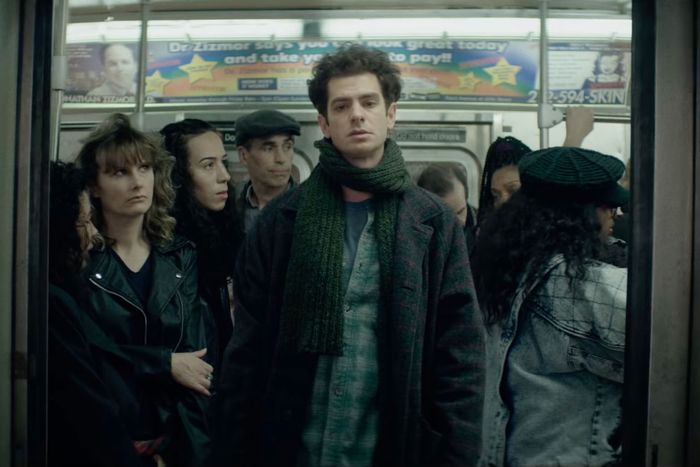
On a whim in college, I took a class on medieval manuscripts, where I learned about the palimpsest: a page where someone has scraped off part of the text and then written something new on top of it, probably to save valuable materials. When you look back on a palimpsest years in the future, you can often see traces of the original writing and the later work at the same time. You see multiple meanings from multiple eras, overlapping (and maybe a drawing of a guy jousting a slug that some monk has scribbled in the corner for fun). The palimpsest rushed to mind while watching Lin-Manuel Miranda’s Netflix adaptation of Tick, Tick … Boom!, a movie that both meticulously restages playwright Jonathan Larson’s autobiographical musical and writes a new text over it with an awareness of what came next: Larson’s sudden death and his influence rippling through the art form of musical theater. It’s a movie that sings, poignantly, from many times at once.
Even before getting to what Miranda and his team added to Tick, Tick … Boom!, it takes some archeological work to describe exactly what happens in the musical. The basic plot: A brilliant young songwriter named Jonathan Larson (played by Andrew Garfield as if there are nerve endings in each of his many curly hairs) strives to write his magnum opus, a work that will revitalize musical theater with the sounds of rock and roll and the anxieties of the moment. In the meantime, he’s fretting over a relationship with his dancer girlfriend Susan (Alexandra Shipp), picking up shifts at a diner, and hustling through the highs and lows of bohemian lower Manhattan in the winter of 1990; there are many coats.
In the show and the movie, the big musical Larson is working on … is not Rent, which would eventually break out into a massive success just after his death by an aortic aneurysm at 35, the night before its first Off Broadway preview. Rather, it’s a sci-fi–slash–MTV piece called Superbia, which the actual Larson did spend years laboring over. In real life, he moved on from Superbia to develop a different iteration of Tick, Tick … Boom! before Rent. But the closest thing to a definitive version was pieced together only after Larson’s death and performed Off Broadway in 2001. (Raúl Esparza’s electric performance as Larson on that cast recording is the way many people end up becoming familiar with the show.) The standard stage version of Tick, Tick … Boom! only requires a three-person cast, and is ideal for a black-box theater — nearly abstract, facing inward, with actors taking multiple roles. But Miranda, an avowed fan of Larson’s work who saw that Off Broadway version and starred in an Encores! revival in 2014, has come in and literalized and expanded the thing for the screen.
His and screenwriter Steven Levenson’s approach to adapting Tick, Tick … Boom! feels like flipping open a thrift-store jacket that wasn’t designed to be reversible, but works anyway. They’ve revealed new colors inside — the blues and grays of Jon’s apartment and the greens and reds of his swimming pool fill in the specifics about bohemian life we are asked to only imagine in the theater. Miranda reteamed with many of his collaborators from In the Heights, including that movie’s cinematographer Alice Brooks and editor Myron Kerstein (credited alongside Andrew Weisblum). Their clique seems intent on both reviving MGM-style musical grandeur and finding clever ways to push movie musicals forward. Those ambitions are evident here in sequences like “No More,” in which Larson imagines life in a luxury-apartment complex: A lobby fills up with a fantastical ensemble of dancing rich people, even as the movie cuts back and forth to the realities of his current run-down, very cold apartment.
Tick, Tick … Boom! begins by immediately telling us in voice-over that, yes, eventually, Larson will write Rent, and yes, far too soon, he will die. When it addresses this inevitability directly, as in that voice-over and a flash-forward to performances of Rent at New York Theatre Workshop, the film can feel like hagiography, reducing Larson to his most successful work and treating that show as unimpeachable. It works far better when the character is in motion, with all the complexity Garfield gives him as he seems to bounce within the walls of his own mind. The actor turns out to have a great voice for a movie musical, strong enough to carry the songs but ragged around the edges. Like Larson, he seems to be burning up as he tries to get all this across — plus, he’s got the athletic dexterity of a former superhero to pull off the dancing.
Like Bob Fosse directing All That Jazz, the movie’s Larson feels like he’s trying to prepare for his own death by staging it (apt, considering Miranda and Levenson executive-produced Fosse/Verdon). In another Fosse-ish touch, Garfield narrates the movie through the frame of an early Tick, Tick … Boom! workshop, which operates as a song-delivery vehicle like it’s the Kit Kat Klub in Cabaret. When Larson and Susan fight, Later Larson sings about the fight in the workshop, in a number called “Therapy.” (He is accompanied in those sequences by Vanessa Hudgens, at the height of her theater-kid enthusiasm, along with Joshua Henry and his silky gravitas.) The gambit sounds unstably meta, but it comes at you with the obviousness of dream logic: Each experience quickly processes into song. You can feel Larson’s thrill as he works through each idea and the annoyance of the people around him (especially Susan) when they realize what he’s doing.
At every turn, Miranda and Levenson provide bits of cultural context. While they’ve cut a few songs — the stage version’s logistically daunting “Green Green Dress” with “20 buttons and a strap” is only described over the radio here — they’ve also dug up a Lonely Island–ish hip-hop piece Larson wrote in a workshop called “Play Game,” underlining what made his own work so different through a send-up of early 1990s Broadway trends like British megamusicals. There is added emphasis on the AIDS crisis, too, which afflicted many of Larson’s friends. It’s both a crucial part of Larson’s story and something the movie treats almost apologetically: that he, a straight white cis guy who did not contract HIV, would go on to write one of the most well-known works of art about New York mid-epidemic. The film’s gestures toward that complex legacy are understandable, but feel incomplete. It can’t zoom all the way out to address, say, activist Sarah Schulman’s criticisms of the commodification of queer culture in Rent because it must remain within Larson’s own mind and creative process. Not that I’d want to turn the movie into a sociological treatise anyway, because it really is a fascinating portrait of this one person’s specific creative process.
As Larson’s gay roommate Michael, a former actor fed up with boho life and now working in advertising, Robin de Jesús has the job of coming in and knocking sense into Garfield. As a pair pulled apart by different reckonings with their own willingness to sell out, theirs ends up being the movie’s most compelling dramatic arc. Jesús is also one of many theater veterans who regularly pop up among the cast. From Laura Benanti running an advertising focus group to Richard Kind as the head of a workshop, there seems to be a Tony nominee’s cameo appearance in nearly every scene. It has the cumulative effect of making the movie that much more theatrical, as if each actor has come in to pay tribute to Larson themselves.
There’s a showstopping sequence midway through the movie filled with so many cameos it may short-circuit a theater lover’s brain, and which Netflix has politely asked reviews not to spoil. But Miranda’s approach to Larson’s legacy was most affecting to me in a scene where Larson runs into Stephen Sondheim (played by Bradley Whitford, mostly eyelid) at a workshop. Sondheim tells Larson that his work is actually pretty good, despite his doubters, and his beneficence hangs over the movie, held up as an example of a previous generation supporting the next. Miranda fills the workshop’s audience with his own contemporaries: musical-theater composers including Shaina Taub, Jason Robert Brown, and Tom Kitt. It gives a moving sense of musical theater’s future written over its past — as if the Larson of the film is surrounded by the ghosts of the things he would inspire, but not live to see.








